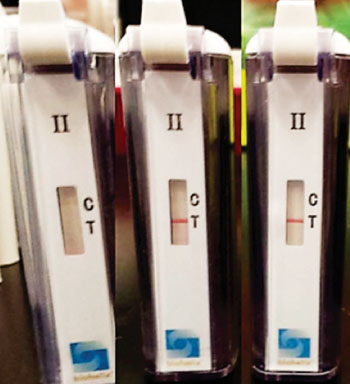Recombinase Polymerase Amplification Assays Developed for Typhus
By LabMedica International staff writers
Posted on 04 Aug 2015
Sensitive, specific and rapid diagnostic tests for the detection of the causative agents of scrub typhus and murine typhus are necessary to accurately and promptly diagnose patients and ensure that they receive proper treatment.Posted on 04 Aug 2015
Rickettsial diseases, lately, are reemerging in areas of known abundance or emerging in areas of unknown existence, posing a significant medical concern for local residents and travelers. The diseases are difficult to diagnose as they often share similar symptoms with many other diseases in the same geographical areas.

Image: Recombinase polymerase amplification (RPA)-nfo assays using cross contamination proof (XCP) lateral flow cassettes (Photo courtesy of Uniformed Services University of the Health Sciences).
Scientists at the Uniformed Services University of the Health Sciences (Bethesda, MD, USA), extracted DNA blood of patients with confirmed scrub typhus which is caused by Orientia tsutsugamushi, an obligate intracellular pathogen, which needs to infect eukaryotic cells in order to multiply. They also spiked normal human plasma with Rickettsia typhi, the causative agent of murine typhus. Recombinase polymerase amplification (RPA) assays using a lateral flow test (RPA-nfo) and real-time fluorescent detection (RPA-exo) were developed targeting the 47-kDa gene of O. tsutsugamushi or 17 kDa gene of R. typhi.
RPA-nfo and RPA-exo kits were both purchased from TwistDx (Cambridge, UK). The evaluation was done using the RPA-nfo for the RPA reaction and the results were evaluated using Milenia Genline Hybridetect-1 (MGH) (Milenia Biotec GmbH; Gieben, Germany). Quantitative polymerase chain reaction (qPCR) was performed to compare and confirm the detection limit of the RPA assay. The7500 Fast Real-time PCR System (Applied Biosystems; Foster City, CA, USA) was used to perform qPCR reactions and analyze the results. A cross contamination proof (XCP) lateral flow cassette was used to detect RPA-nfo amplicons.
Eight out of ten PCR confirmed positives were determined positive by RPA, and all PCR confirmed negative samples were negative by RPA. Similar results were obtained for R. typhi spiked patient sera. The assays were able to differentiate O. tsutsugamushi and R. typhi from other phylogenetically related bacteria as well as mouse and human DNA. The RPA-nfo reaction was completed in 20 minutes at 37 °C followed by 10-minute incubation at room temperature for development of an immunochromatographic strip. The RPA-exo reaction was completed in 20 minutes at 39 °C.
The authors concluded that the assay had a detection limit similar to that of qPCR. The assays were also evaluated using extracted DNA from human patient samples, demonstrating around 80% sensitivity and 100% specificity using limited clinical samples. The ease with which the cross-contamination-proof lateral flow cassette can be used to detect multiple amplicons from various nucleic acid amplification methods makes it promising for wide-ranging use in the field. The study was published on July 10, 2015, in the journal Public Library of Science Neglected Tropical Diseases.
Related Links:
Uniformed Services University of the Health Sciences
TwistDx
Milenia Biotec GmbH














